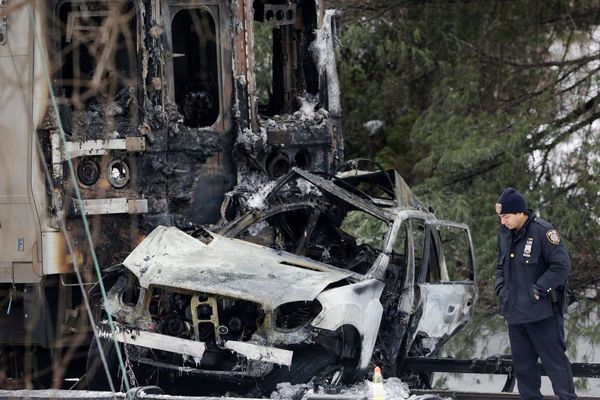“A Haunted History of Invisible Women: True Stories of America’s Ghosts” by Leanna Renee Hieber and Andrea Janes; Kensington (368 pages, $16.95)
———
Seeing isn’t always believing.
A figure in an old gown is glimpsed at the top of the stairs, a face looms briefly from the shadows. But everyone knows there’s no such thing as ghosts.
Are there?
Leanna Renee Hieber and Andrea Janes aren’t so sure.
Janes is the founder of Boroughs of the Dead, a haunted-house tour of New York City; Hieber is one of its guides. They also write supernatural fiction, but “A Haunted History of Invisible Women: True Stories of America’s Ghosts” is their first book together.
And it’s based on fact.
Based on serious research, too. Janes and Hieber are open-minded but clear-eyed. When there’s a good story, they tell it. When it seems too good to be true, they also report that.
They’re also open to the stories behind these stories and what they say about gender, sex, and society.
“Historically, women have always lived cheek by jowl with death,” Janes writes in her introduction (the authors sometimes alternate chapters, other times they collaborate). “We hover near the border of death for hours, sometimes days, during the delivery of children, and historically, we have very often died in the process.”
Yet not only are women more aware of mortality on earth, they seem to be – at least in legend and literature – more marked for immortality once they depart it. Female ghosts dominate spooky tales around the world.
These tales’ not-so-subtle moral?
“The unleashed feminine, that awesome maelstrom of incredible sexual and physical power,” writes Janes, “is dangerous and often leads to a terrible afterlife.”
The two writers collected spectral stories from over 300 years on subjects from dowagers to slaves, killers to victims. However varied their lives were, they shared thwarted desires and, often, bloody violence.
And second, these stories, and our interpretations of what’s not easily believed, are complicated.
Both authors write about Salem, Massachusetts, the capital of America’s witch hunts and a place rich in ghostly history. Today, the town lures tourists with a playful approach, hosting a smiling statue of Samantha from TV’s “Bewitched.”
But the reality was far uglier, the authors say. These were real women targeted for their outspokenness, their property, or their unconventional lives. One supposed witch, Bridget Bishop, scandalized the town by, among other sins, wearing a red blouse.
She was hung for witchcraft, still proclaiming her innocence.
Today, her ghost is said to haunt the seafood restaurant that now stands on her land. There, reports Salem expert Sebastian Crane, patrons have noticed “inexplicable electrical difficulties, flying glasses, and silverware quietly vanishing.”
A Massachusetts crime scene of a very different sort draws other tourists to Fall River, where in 1892, Lizzie Borden took an ax and hacked up her parents. Or so goes the story and the song – “she gave her mother 40 whacks and when she saw what she had done, gave her father 41.”
However, the murder weapon was never found, and Borden was acquitted. She died a wealthy woman, and her hometown profited from her notoriety. Tourists – some true-crime fans, others ghost-hunters – still visit. The Borden house is now a bed-and-breakfast, and the staff describes a place with “mood swings,” haunted by ghostly footsteps and slamming doors.
“The strongest rooms for me are the basement and the third floor,” says a former manager. “I don’t scare easily but have been ‘unglued’ a few times when I’m alone.”
The authors are less open to the supernatural claims of the Winchester Mystery House in San Jose, California.
Legend has it that the owner, Sarah Winchester, widow of the wealthy rifle manufacturer, feared the murdered victims of his invention. After the Civil War, she fled the couple’s Connecticut home and built an ornate California mansion designed to be so confusing that no spirit could navigate it.
Yet, Hieber points out, Winchester moved West to join her sister. She kept adding to her house because she was an enthusiastic – if entirely amateur – architect. There’s no record of her ever seeing any ghosts. She died peacefully, in bed, in her 80s.
Nine months later, her home was sold to an entrepreneur. It’s been a tourist attraction since, and ghosts are part of the attraction.
Still, Hieber isn’t willing to deny the place has a particular atmosphere. People have reported hearing strange singing or glimpsing a figure lurking in the basement. “One of the old workmen, ‘Clyde,’ appears often around the grounds in a distinct pair of overalls and Victorian boater hat,” Hieber writes.
Although Hieber and James give ghost tours, they maintain that they stick to the facts. Others, they charge, may not be so particular.
The Sorrel Weed House of Savannah, Ga., is popular on local ghost tours. Guides spin tales of an antebellum merchant who married the daughter of his business partner — while continuing to rape an enslaved woman. When his wife found out, she threw herself off the balcony. The enslaved woman followed her in suicide, hanging herself in the barn.
Both spirits, guides insist, haunt the property to this day.
Or do they? A little checking shows the wife died at a neighboring house and that the enslaved woman left Savannah alive in 1857. But you can’t let facts get in the way of a ghost story.
The authors also find specters closer to home. The Merchant’s House Museum in Manhattan’s East Village is reportedly brimming with spirits. Visitors report hearing footsteps or feeling invisible hands brush their arms. Unseen bells ring, summoning long-dead servants.
One visitor was greeted at the door by a woman in a Victorian dress who told him the house was temporarily closed. When he returned later, he was welcomed in by a confused staffer who knew nothing of this woman.
Later, taking the tour, the visitor saw the mysterious woman again – in an oil painting. It was the house’s long-dead owner.
The authors’ favorite ghostly New York story, though, features Joan Rivers. She moved in the mid-1980s into an old condo on East 82nd Street, embarking on extensive renovations. The well-appointed apartment was always strangely icy, and the electricity flickered. Her Yorkie was terrified.
Rivers complained to the super. “Oh, I guess Mrs. Spencer is back,” he said. It turns out that everyone knew a former tenant haunted the unit.
So Rivers got the number of a New Orleans voodoo priestess. She flew the woman up to do a cleansing. It worked, but only briefly. Then, luckily, Rivers found an old painting of an elegant lady stored in the basement.
“Mrs. Spencer,” the doorman told her.
Rivers had the portrait hung in the lobby. Suddenly her condo was at peace. And Rivers – whose career was at a low point – rebounded.
“My whole life turned in that apartment,” Rivers said. “What I did for her is I restored her home. So we both gave each other something that we both love.”
The facts, Janes says, are a bit different.
Rivers’ paranormal help came not from a voodoo priestess from Louisiana but a Jewish ghostbuster from Maine. And there’s no record of any Mrs. Spencer living at that address. But in the end, that makes it no different from most ghost stories.
Sometimes, seeing isn’t believing.
But sometimes, believing is all that matters.







